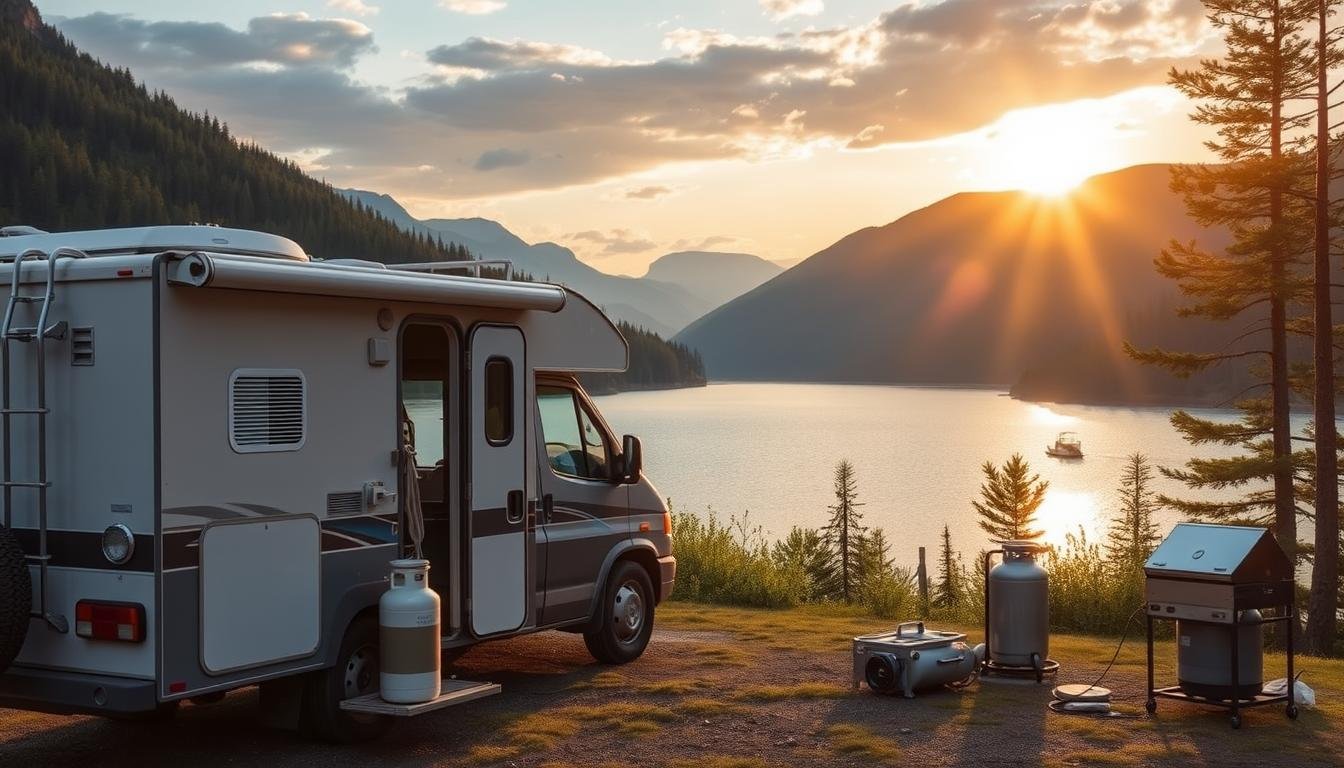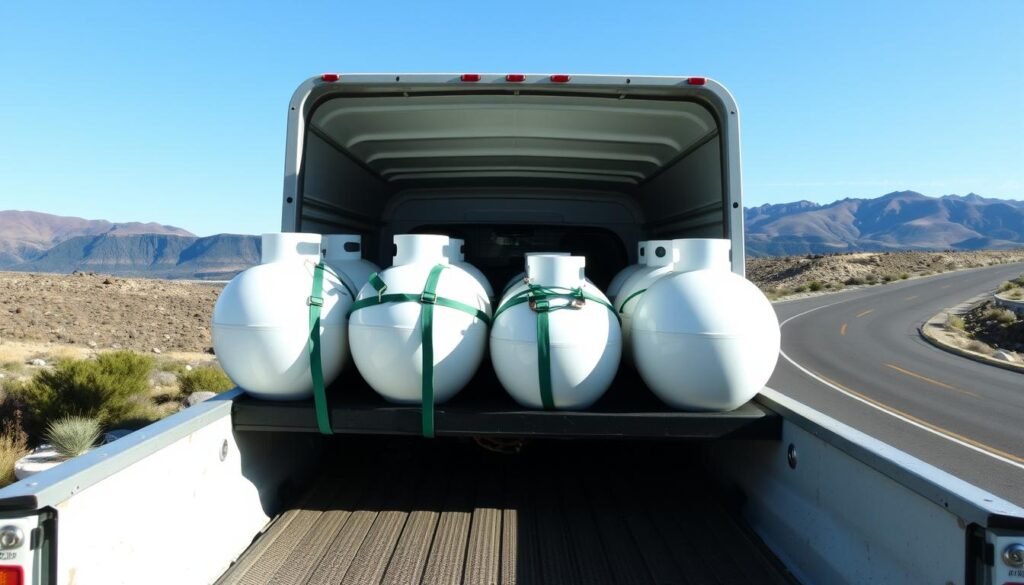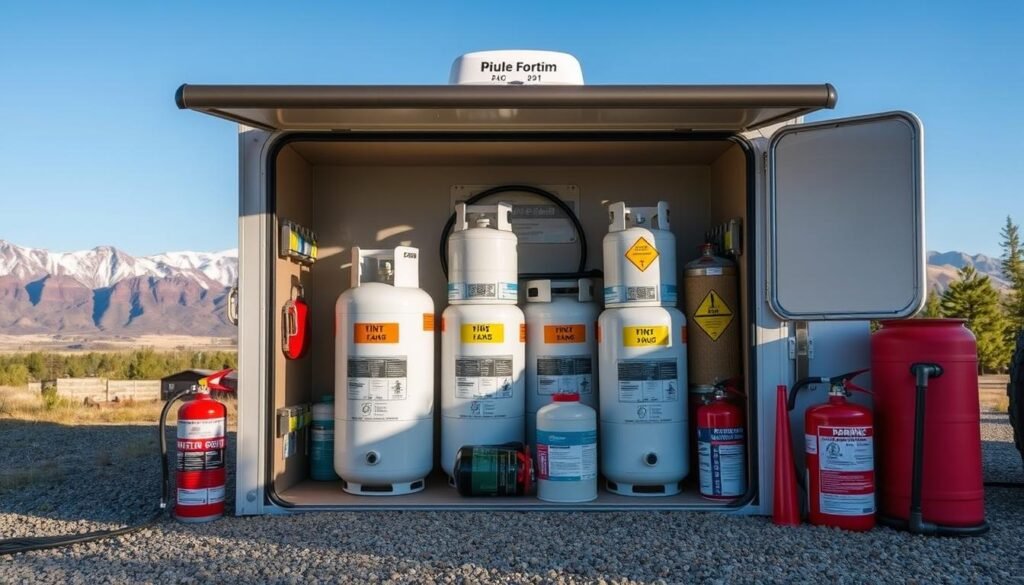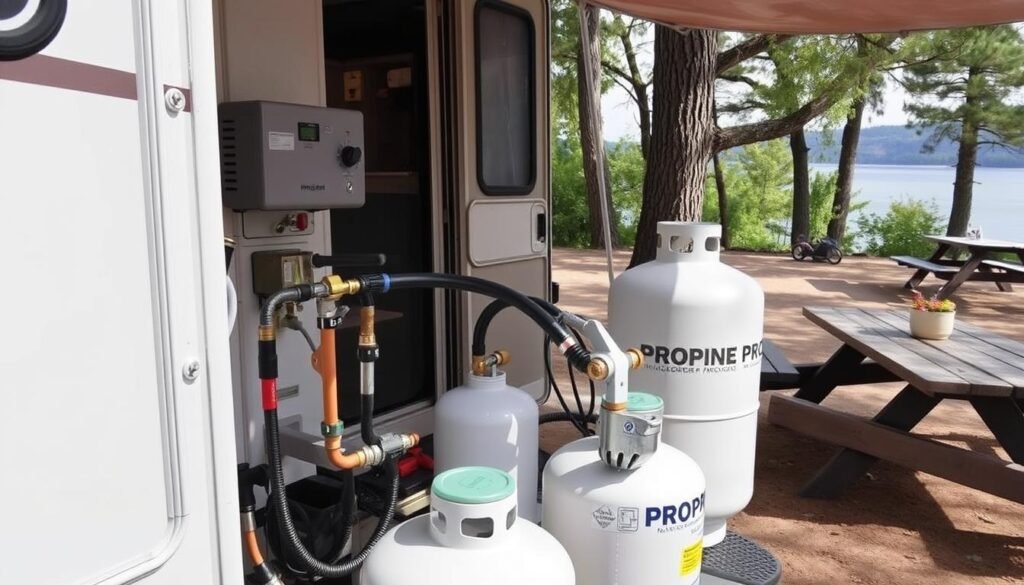Propane is great for outdoor activities like heating, cooking, or grilling. Many people refill their tanks at local stations all year. But, it’s key to know the rules for moving these tanks to avoid accidents.
Handling or storing propane tanks wrong in cars can be very dangerous. It might even cause tank explosions. This article will give you all the info you need to travel safely with propane. We’ll cover rules, best practices, how to store them, what to do in emergencies, and delivery services.
Key Takeaways
- Ensure propane equipment is certified for use in the country you’re traveling to.
- Reusable 5-pound cylinders are an eco-friendly alternative to 1-pound disposable tanks.
- Properly secure and ventilate propane tanks when transporting them in your vehicle.
- Store propane tanks outdoors in a well-ventilated area, away from heat or ignition sources.
- Be prepared for emergencies and know the signs of potential propane leaks or carbon monoxide poisoning.
Can You Travel with Propane?
Traveling with propane tanks can be handy for RVs, camping, or outdoor gear. But, knowing the rules for safe transport is key. The Consumer Product Safety Commission reports about 600 propane tank explosions yearly. Carrying a faulty or leaking tank can raise the risk of accidents.
Regulations and Guidelines
The rules for can you travel with propane depend on the tank’s size and type. They also vary by transport method (car, RV, airplane, etc.). Generally, you can carry up to four propane cylinders in a car or SUV. Each cylinder should hold no more than 45 pounds of propane. The total weight of all cylinders in a car should not go over 90 pounds.
Types of Propane Tanks for Travel
For types of propane tanks for travel, you have many choices. This includes small portable tanks and bigger ones for RVs and camping. Portable propane cylinders are very safe, with rare accidents. Most accidents happen when gas leaks out near a flame because of an open valve.
| Tank Type | Capacity | Suitable for |
|---|---|---|
| Small Portable Tank | 1-20 lbs | Camping, Grilling |
| RV Cylinder | 10-30 lbs | RV, Camping |
| Larger Cylinder | 30-100 lbs | RV, Heating, Cooking |
Knowing the propane tank regulations is crucial. Choose the right propane tanks for your travel needs. This ensures a safe and fun trip.
Best Practices for Transporting Propane Tanks
When you travel with propane tanks, safety is key. There are important steps to follow for a safe trip.
Securing the Tank
Always keep the propane tank upright when moving it. Use a special holder or a milk crate with rope to keep it steady. This stops the tank from moving and prevents leaks or accidents.
Ventilation and Valve Closure
Good air flow is vital when moving propane tanks. Place the tank near a window for air. Also, make sure the tank’s valve is closed, even if it’s empty. This stops propane from leaking during the trip.
By following these tips, you can safely move your propane tank. This ensures your journey is both safe and responsible.
“Education on safe transportation practices is key to avoiding hazards related to improperly transporting propane cylinders.”
You can carry up to four propane cylinders in a car, each with 45 pounds of propane. The total weight in a car should not be over 90 pounds. For trucks or trailers, you can carry up to 1,000 pounds of propane.
It’s crucial to transport propane tanks safely. Focus on secure storage, good air flow, and closed valves. This way, you can enjoy propane fuel safely on your travels.
Storing Propane Tanks During Travel
When traveling with propane tanks, it’s key to store them right. Keep propane tanks outside, away from the sun. Don’t put them in sheds, garages, or RVs.
As soon as you arrive, put the tanks in a safe spot. Don’t leave them in a car for too long.
Storing propane tanks safely is very important. Propane is heavier than air, so tanks must be stored where vapors can’t build up. You can only carry four propane cylinders in a car at once. Each cylinder can’t have more than 45 pounds of propane.
When moving propane tanks, secure them to a flat surface. Open the car windows a bit for air. It’s smart to fill tanks to only 80% capacity to avoid vapor pressure buildup. Use milk crates or trailer hitch racks to keep tanks steady.
| Propane Tank Storage Tips | Propane Tank Transportation Tips |
|---|---|
|
|
By following these tips for storing propane tanks during travel and transporting them safely, you can have fun outdoors. Always check with propane experts for the latest advice on storing tanks and safety.
Camping and RVing with Propane
Propane is great for camping and RVing. It’s easy to carry, efficient, and clean. It’s perfect for powering appliances and heating in RVs and campsites. Knowing how to safely connect propane tanks is key for a good time.
Connecting Propane Tanks to Appliances
When camping or RVing, follow the maker’s guide for propane tank use. Make sure the tank fits right, connections are tight, and the valve is fully open. This prevents leaks and keeps you safe.
- Find the right propane tank size and type for your RV or gear.
- Check the tank, hoses, and fittings for damage or wear before use.
- Keep the propane tank in a safe spot to avoid it moving while traveling.
- Connect the tank to the regulator and appliances, making sure all connections are tight.
- Do a leak test with soapy water on the connections. Bubbles mean a leak.
- Know where the emergency shut-off valve is and how to use it in an emergency.
By following these steps, you can enjoy propane’s benefits on your camping with propane and RV propane travel trips. You’ll stay safe and have a great time.
Flying with Propane Tanks
Traveling by air has strict rules for propane tanks. These containers are seen as hazardous materials. So, you can’t bring propane tanks on commercial flights, in carry-on or checked luggage.
But, there are some exceptions. Small propane tanks for camping or cooking might be okay. They need to fit certain size and packaging rules. Always check with your airline and the TSA before flying with propane.
Airlines have rules for backpacking and camping stoves. New stoves in original packaging are allowed in bags. But used stoves must be clean for TSA inspection. Liquid-fuel stoves need a deep clean with soapy water.
The FAA also has rules for items like batteries and flammable materials. Fuel bottles must be uncapped and clean for travel. Full liquid-fuel bottles and gas canisters are not allowed.
Carrying propane tanks on planes is risky. There have been cases of leaks causing fires or explosions. The danger depends on the propane container’s type.
But, FAA-approved tanks for ballooning are safer. Smaller camp stove bottles might also be okay. However, buying them on-site might not save much money.
In summary, the dangers of flying with propane tanks are too great. It’s important to follow airline and TSA rules for everyone’s safety.
Propane Regulations for Different Modes of Travel
Transporting propane tanks has different rules for each travel method. Whether you’re driving or flying, knowing the rules is key. It helps keep your propane tanks safe and legal.
Road Travel
For driving, like in a car or RV, there are rules to follow. These include how many tanks you can carry, their weight, and how to secure and ventilate them. The Department of Transportation (DOT) sets these rules for safe road transport.
When driving with propane tanks, keep them upright and stable. Use ropes or straps to hold them in place. Also, keep a window open for air to circulate.
Air Travel
Most airlines don’t let you bring propane tanks on planes. But, some small tanks for camping or cooking might be okay. Always check with the TSA and your airline for the latest rules.
Carrying propane on planes is risky. The chance of accidents or fires is high. This is why it’s not usually allowed.
Always check the rules for transporting propane, whether by road or air. By following the guidelines and taking safety steps, you can transport your propane tanks safely and legally.
Emergencies and Safety Precautions
What to Do in Case of a Leak
Propane is very flammable. If there’s a leak, act fast. Signs of a leak include a smell like rotten eggs.
Get out of the area right away. Move far from the leak. Don’t try to fix it yourself. It’s too dangerous.
Call the fire department or a propane expert. They know how to handle it safely. Propane leaks can be very dangerous.
Propane is a Category 1 Flammable Gas. It’s very dangerous. Always be careful around it.
- Evacuate the area immediately and move a safe distance away.
- Do not attempt to repair the tank or stop the leak yourself.
- Contact the local fire department or an authorized propane service provider.
- Avoid any potential ignition sources, such as open flames, sparks, or electrical equipment.
- Ensure proper ventilation and avoid confined spaces where propane could accumulate.
“Propane is an EXTREMELY FLAMMABLE GAS that can accumulate in hazardous amounts in confined spaces and may cause frostbite upon direct skin contact with the liquefied gas.”
By following these steps, you can stay safe. Protect yourself and your family in emergencies.
Propane Tank Delivery Services
Levco’s Propane Exchange program makes getting propane tanks easy and safe. You don’t have to carry heavy tanks or wait in line. Their team delivers tanks right to your door, following all safety rules.
This service saves you from the trouble of moving tanks yourself. Levco’s delivery is secure and reliable. So, you can enjoy your outdoor time or home needs without worrying about tank transport.
Levco serves a wide area, including Delmarva and more. Their trucks can reach your tank, even if it’s hard to get to. Choosing Levco means no more hassle or safety risks from moving tanks yourself.








